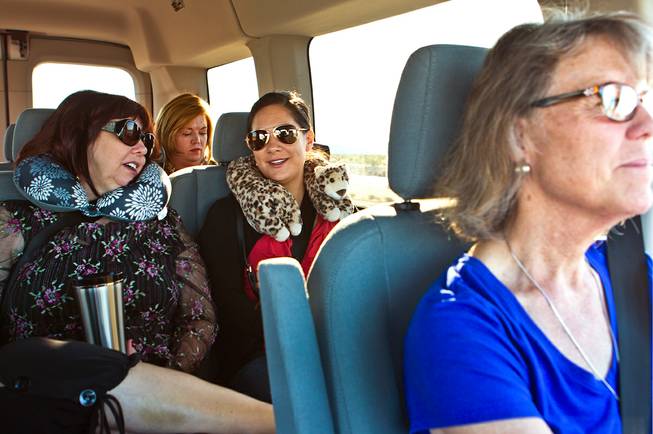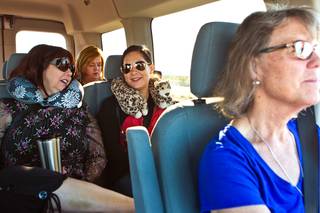
Helen Knight, right, drives a group of her teaching colleagues to Baker, Calif., to work on Tuesday, May 3, 2016. The group departs every weekday morning from Las Vegas at 6 a.m. for the commute to Baker. In the seat behind Knight are Roxanne Lang, left, and Tina Delgadillo. In the rear seat is Stacy Hertig.
Friday, May 6, 2016 | 2 a.m.
Roxanne Lang sinks into the backseat, munching on a breakfast of toast swaddled in a paper towel.
At 6:30 a.m., traffic is still light on Interstate 15 southbound out of Las Vegas. Up ahead, the town of Jean appears from behind a mountain, a small gray oasis on a brown landscape. It’s usually around here that the chatter between Lang and the other teachers in this white Ford van trails off into silence as they settle in for the ride.
If they worked in Clark County, they’d probably be waking up right about now. But these teachers follow a different schedule. Every day they drive 180 miles — around three hours round trip across state lines — to teach in Baker, Calif.
Asked why, they answer in unison.
“Because we’re all crazy,” they say, laughing, as the van trundles down the highway.
Then again, maybe not. Every year, big-city school districts watch in horror as hundreds of teachers retire or quit the profession, leaving hundreds of classrooms without a qualified teacher. Right now, Las Vegas schools are short hundreds of teachers.
And if those who leave the profession could be described as victims of the shortage, these teachers are the refugees.
Helen Knight, Baker’s middle school history teacher, discovered the school during a road trip to see family in Southern California. She remembers what it was like to teach in Orange County.
“I’ve had 32 kids in a class,” she said, eyes on the road. “I loved teaching, but it was hard to zero in on the specific needs of the kids.”
Lang, a speech pathologist, started working at the school in the early 1990s.
She, like the other eight teachers who comprise the Baker caravan, considered working at CCSD but quickly decided against it.
“Quite frankly, the pay scale was ridiculous,” said Lang, who lives within walking distance of a middle school in Henderson. “I had all this experience, but they weren’t willing to pay for it.”
That hasn’t changed much in the 25 years she’s been commuting to Baker. The starting salary for teachers in the tiny desert town is $44,000. In Las Vegas it’s $34,000, though it will be $40,000 next year after a new contract takes effect.
At the same time teacher shortages are ravaging America’s cities, however, rural schools have arguably been hit hardest. Teacher turnover is high, and many small towns are finding it hard to attract teachers.
“Rural schools today aren't the pastoral institutions of a simpler yesteryear that many Americans imagine,” former education secretary Arne Duncan told a gathering of the American Association of School Administrators in 2010.
But things are different in Baker, population 700 and change.
The school stretches out on a sandy patch of high desert steppe on the northern edge of town. Its handful of old buildings, the sum of the Baker Valley Unified School District, sit amid groves of tall palms and oaks fattened by spring showers. Aside from an occasional private plane sputtering on final approach to a nearby airstrip, things are quiet here.
“It’s the best-kept secret in the desert,” said Ronda Tremblay, principal of the school and superintendent of Baker Unified.
It’s a soft-spoken counterpoint to prototypical urban schools, with their chain-link fences and overcrowded classrooms. While many are attracted to Baker because of the pay, they stay because the work is satisfying, the way teaching should be but often isn’t in large urban school districts.
“I don’t think it’s worth it when I have 30 kids who don’t know me,” said teacher Katherine Souratha, dishing up a bowl of homemade tortilla soup during lunch on Teacher Appreciation Day this week.
“At least here I get paid more and get free food,” she says with a grin.
Class sizes are small, often unbelievably so. Alan Acosta, also from Vegas, teaches high school math. In one of his morning sessions, there are only three students.
“It’s not just that you get to know the kids in your own classes, you get to know everyone,” said Marco Rudolph, a part-time substitute at the school.
With the exception of the superintendent and a few teachers, almost all of the staff lives elsewhere, even the cafeteria lady.
Teachers drive in from a number of California towns, including Palmdale, Apple Valley, Hesperia, Barstow and Kelso. A second van of teachers arrives from Victorville, but the record for longest commute goes to Art Gonzalez, the second-grade teacher who drives in each day from San Dimas near Los Angeles.
The lack of housing and amenities like a grocery store and bank mean it’s hard to get teachers to move to the town, forcing the school district to be creative. The Ford Transit vans used by the carpooling teachers are owned by the district, and teachers help offset their costs by paying $70 a month to use them.
“It’s an expense you have to make to get teachers to come out here,” said Bryan Verley, the school’s business manager.
The journey to Baker takes the teachers past the Mojave Desert’s sprawl of far-flung rest stops and gas stations, ramshackle buildings obscuring trailers and mobile homes from which students emerge every morning to catch school buses.
When the road smooths out, Lang takes off a pair of dark sunglasses and applies mascara.
They haven’t always had it this good. Before the district gave them a van, Lang and Acosta drove an old Chevy Lumina. The air conditioner didn’t work, so they kept a stash of spray-fan bottles on hand during summer.
“We had a wet T-shirt contest every day,” Lang says.
“It was unbearable,” Acosta whispers.
In Baker, a town known mostly for its world-famous towering thermometer and as a final pit stop before Nevada, three quarters of the residents are Hispanic and Latino.
They find work in the many gas stations, fast food joints and truck stops that line Baker Boulevard, the main drag which, along with the Mad Greek restaurant, doubles as the only hangout spot for the town’s high schoolers.
“We just walk around Baker and eat,” freshman Alex Munoz said.
If the small-town feel benefits anyone, it’s the students. The school is 90 percent Hispanic, and many speak English as a second language.
“We get more one-on-one with teachers rather than having to wait in a long line of students,” said junior Emelie Fisher, relaxing at a picnic table in the school’s courtyard.
“It’s pretty amazing that they come all this way just to teach us,” she added.
When the bell rings, she gets up to join a handful of students heading quietly to class. There’s no yelling or running. When teachers arrive, they’re met with a warm smile and a hello.
The pay is a plus, but ask any teacher here and they’ll say the students themselves are the reason they keep coming back.
“This is a just really nice place to work,” said Paul Bachman, a history teacher who commutes every day from Las Vegas in his own car. “I love these kids to death.”
In a few days it will be Cinco de Mayo, just another holiday in some schools. But here, it’s a tradition for students to bring in pots of homemade pozole, a traditional Mexican soup, to share.
“Sometimes, it’s about more than the money,” Tremblay said.


Join the Discussion:
Check this out for a full explanation of our conversion to the LiveFyre commenting system and instructions on how to sign up for an account.
Full comments policy